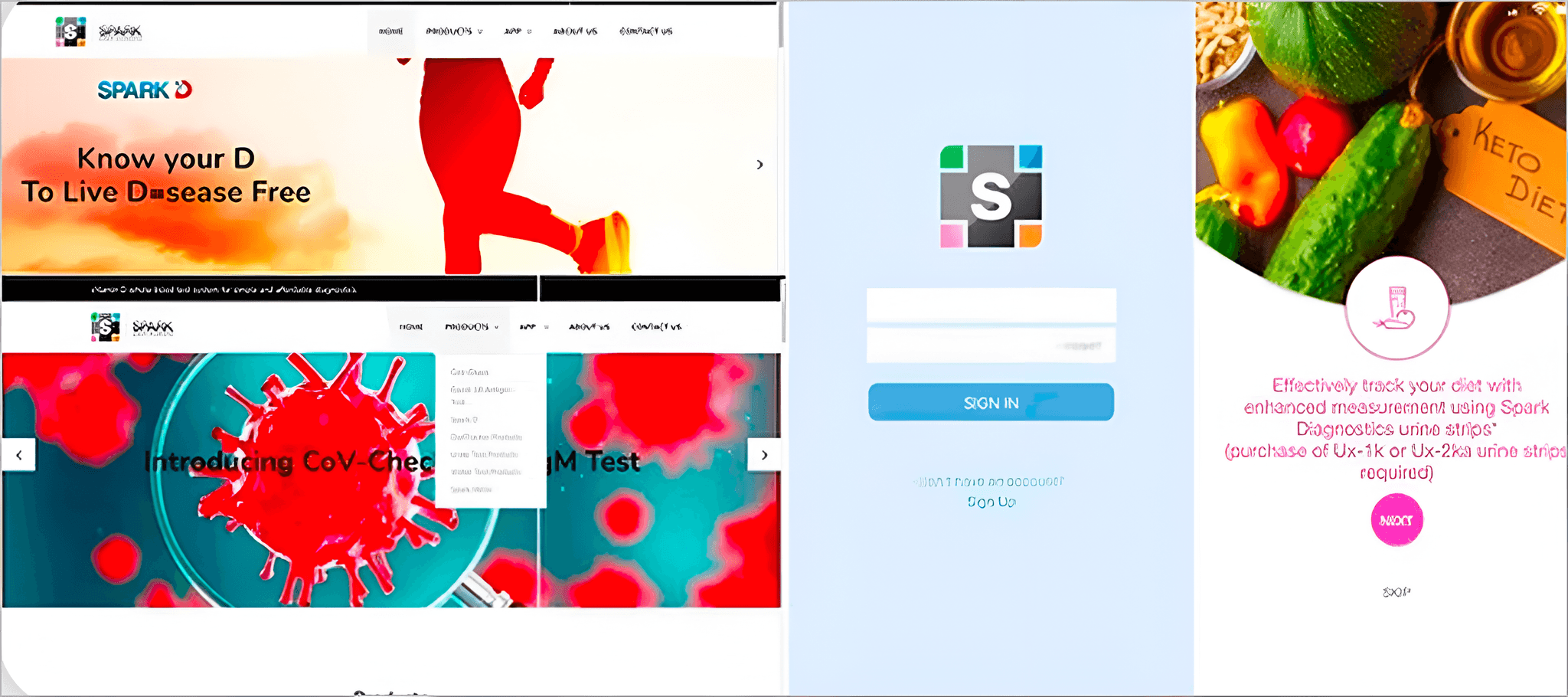Transforming healthcare with portable, smartphone-based diagnostics.
CONTEXT
Health testing that fits in your pocket and shows results instantly.
Spark Mobile Diagnostics provides portable testing kits that deliver instant results for critical health metrics like Vitamin D and CRP levels through a smartphone app, enabling testing anytime, anywhere.
PROBLEM
Fragmented tools hindered patients’ ability to manage their health results effectively and communicate with doctors.
Spark's fragmented platform required multiple apps for different tests, lacked doctor access to patient data, and suffered from inconsistent UI design - all compromising usability and efficiency.
P 1
"Why do I need separate apps for different tests? It’s so confusing to keep track of everything."
P 2
"I just want to send my results to my doctor easily and get their feedback without any hassle."
SOLUTION OVERVIEW
Bringing all health tests into one place, transforming fragmented diagnostics into a seamless experience for patients and doctors alike.
The app unifies all of Spark's diagnostic tests into one platform, allowing users to track results, follow guided instructions, and share reports with doctors.
Key additions include a kit glossary, doctor consultation flow, and visual consistency across app, website, and packaging.
IMPACT
Live & running!
55%
decrease in test-taking time during prototype testing, significantly improved user experience and test completion rates
100%
of testing users found the redesign more intuitive, eliminated the need to download multiple apps to track tests
Unified
fragmented testing experiences into a single cohesive platform, strengthened brand identity and boosted user retention
Launched
the redesigned Spark website - my proposed features are now live, with the unified app in active development
MY CONTRIBUTION
End-to-end design leadership.
Process + Complete Solution ↓
TARGET USERS
We narrowed on three distinct but interconnected user groups with unique needs, key to the overall experience.
1
Those managing chronic conditions or proactively monitoring health
Prefer at-home testing over hospital visits
CORE
STRATEGIC
2
Adult children/relatives managing care for elderly parents
Need to monitor loved ones' health remotely
3
Doctors requiring efficient patient data access
Need clear presentation of the test results
STRATEGIC
RESEARCH INSIGHTS
High-level findings that guided the design.
Different apps for different tests & visual inconsistencies
Users struggled with navigating multiple apps for different tests, leading to confusion and inefficiency.
"Why do I need separate apps for different tests? It’s so confusing to keep track of everything."
Absence of communication with their doctors
Doctors lacked tools to easily receive or analyze patient data, complicating communication.
"I'd like to get the results for my tests and share them with my doctor to get their opinion."
Underserved caregiver needs
Family guardians expressed the need to be able to easily track the health of their loved ones.
"My elderly mother has trouble staying hydrated, so this is a godsend for us to be able to catch the dehydration…"
Lack of clarity on test kit usage instructions
Inconsistent visual design across touch-points (web, app, packaging) made the products feel disconnected.
" What is a unisampler? What's a blood lancet? It's hard to figure out what objects these test kits are referring to."
DESIGN CHALLENGE
How might we create a single platform that simplifies health testing for individuals, allows family guardians to track their loved ones' health, and streamlines result sharing with doctors?
DESIGN REQUIREMENTS
Based on the above insights, these were the must-haves for our design.
Combine multiple test apps into a single, intuitive platform.
Enable users to share their results instantly with doctors.
Enable "reverse-parenters/guardians" to keep track of their loved ones.
Make test kits instructions clearer and comprehensible.
WIREFRAMING AND USER FLOWS (APP)
The mellow team had a basic wireframe & flow for the app in place which I worked with and refined to meet the design requirements.
The goal was to consolidate existing test flows, design the doctor interface, simplify test-taking, and enable family health tracking. I refined the team's initial wireframes by adding a kit glossary, guardian flows, and test-specific result visualizations.
VISUAL DESIGN AND BRANDING
Once the flow and features were decided, I worked on ideating how the final product would look.
Key design decisions:
I selected an orange theme for its association with vitality, energy, and balance.
The typography was paired with a hand-written font to bring in the feel of a doctor's handwritten prescriptions (yet keeping it legible!).
A 3D iconography style that brought in warmth, and a friendly factor to the overall product.
FEATURE IMPLEMENTATION
Finalising the features that aimed to meet our design requirements.
FINAL DESIGN - APP
Here's how it all came together - Some screens out of the total 283!
THE WEBSITE
After the app, I worked on Spark's website, following a similar iterative process.
I created the complete framework for the website in the form of low fidelity wireframes.
FINAL DESIGN - WEBSITE
This is how the website looked!
Below were the major improvements made compared to the previous versions -
NEXT STEPS
The app is now in development, and the first cut of Spark's website is live & running!
Along with the two main deliverables, Spark has also adopted my rebranding on its packaging and other marketing collateral, making it a cohesive product across all of its touchpoints.
IMPORTANCE
Why does this solution matter?
Portable testing revolutionized healthcare by bringing diagnostics directly to people's homes. It proved especially valuable during post-COVID recovery, helping those unable to visit hospitals due to physical limitations or other obligations, transforming medical access from a challenge into a convenience at their fingertips.
REFLECTION
Acknowledging limitations & what I would do differently.
Due to time constraints, I was unable to conduct a proper usability study with the final product. We did initial testing with the prototype, but I see this as an opportunity to test Spark in the real world and build on it.
Involving more number of relevant users (healthcare professionals) throughout the research and ideation process itself would be more helpful and impactful in designing a true user-centered solution with more innovative thinking (participatory design/co-design methods).



















